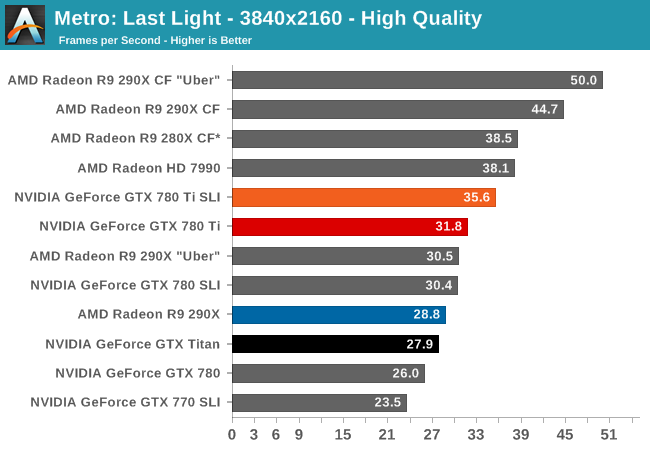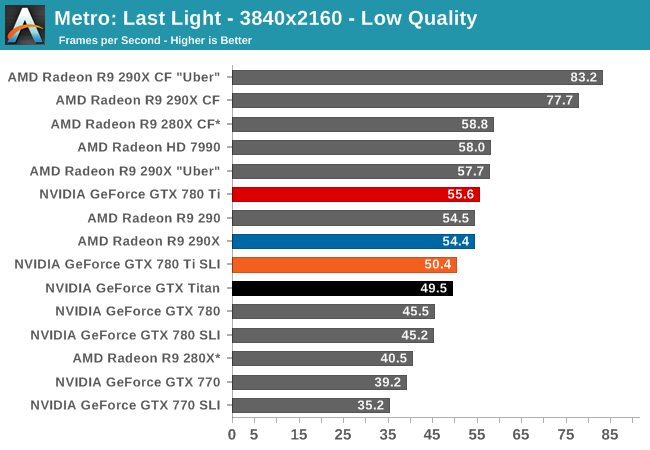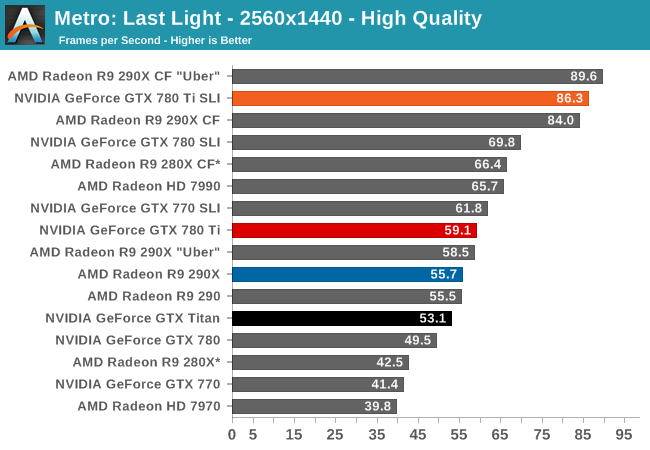The NVIDIA GeForce GTX 780 Ti Review
by Ryan Smith on November 7, 2013 9:01 AM ESTMetro: Last Light
As always, kicking off our look at performance is 4A Games’ latest entry in their Metro series of subterranean shooters, Metro: Last Light. The original Metro: 2033 was a graphically punishing game for its time and Metro: Last Light is in its own right too. On the other hand it scales well with resolution and quality settings, so it’s still playable on lower end hardware.



For the bulk of our analysis we’re going to be focusing on our 2560x1440 results, as monitors at this resolution will be what we expect a single GTX 780 Ti to be primarily used with. A single card does have the necessary horsepower to drive a 4K monitor on its own, but only at lower quality settings. Even as powerful as GTX 780 Ti is, a pair of them will be needed to get good framerates out of most games if using 4K at high quality settings.
Looking at our Metro: Last Light results then, it’s the start of what’s going to be a fairly consistent streak for the GTX 780 Ti. Though it doesn’t improve on GTX Titan or GTX 780’s gaming performance by leaps and bounds, the additional SMX and increased clockspeeds means that it has little trouble pulling away from those cards and from AMD’s 290 series. As a result the GTX 780 Ti beats the GTX Titan by 11%, GTX 780 by 19%, and though it’s closer than normal, the lead over the 290X stands at 6%.
To that end in Metro it leads the pack of single-GPU cards, though it does come up just short of being able to average 60 frames per second at 2560. Anything over 60fps will require multiple GPUs; and even then GTX 780 Ti is fast enough that sometimes even a pair of GPUs (GTX 770 SLI) isn’t going to be appreciably faster.
Meanwhile looking at GTX 780 Ti SLI performance, the SLI setup tops the charts at 2560 for everything short of the 290X in uber mode, though in this case (like most cases) two high-end GPUs is on the verge of being overkill even at 2560. Otherwise looking at 4K, NVIDIA’s poor 4K scaling on Metro once again makes itself present here, with NVIDIA’s performance only minimally benefitting from the second card. In the case of Metro at 4K, the 290X CF is going to be by far the faster option.










302 Comments
View All Comments
mohammadm5 - Monday, November 11, 2013 - link
http://www.aliexpress.com/item/Wholesale-Price-GeF...thats the wholesale price its not nvidia that charges so much is the resellers. the profit nvidia makes per gpu is very low but the reseller make alot of money, also the new amd r9 290 is going for $255 per unit at wholesale price and the r9 280x is going for $160 dollar per unit. you have to also remember thats the distributer price not the manufacturer price,witch should be alot lower. i know the gtx 780 at manufacturer price sells from $200 to $280 depending on brand.
so remember this is america were they sell you something made in china for 1 dollar for 10 dollars
UpSpin - Monday, November 11, 2013 - link
While those numbers are interesting, your conclusion is wrong. The $700 are what NVidia wants the customer to pay for the card, not what the reseller wants:http://nvidianews.nvidia.com/Releases/NVIDIA-Unvei...
"Pricing is expected to start at $699"
So it's not the seller who makes 100% profit, it's NVidia.
polaco - Monday, November 11, 2013 - link
remember that the reseller has to buy the card, pay import taxes, transportation and others, try to sell it and if the card goes unsold they have to sell it in a few month at discounts prices. Also in the case of psychical stores they have to keep building costs, employees, more taxes, etc. So what you are describing happens in every industry. Also and maybe in first place where are you getting those numbers from?Wade_Jensen - Monday, November 11, 2013 - link
OK, so either Brian has lost his Nexus 5 or its benchmark boosting, cause something has to be going on here.beck2448 - Monday, November 11, 2013 - link
Wow oc results are impressive. Where are the Lightning and Windforce versions?r13j13r13 - Tuesday, November 12, 2013 - link
la ventaja frente a una 290x es mínima pero la diferencias de precio no cuando se mejore la refrigeración de la 290x, al fin y al cabo la competencia nos beneficia a todosjukkie - Tuesday, November 12, 2013 - link
HD7990 can be gotten for as low as £400 in the UK at the moment (or £480 with a PSU or a M/B), so anyone wanting the ultimate in single CARD performance would bet better off buying that anyway.Obviously noise and heat will still be an issue, but if you're going to ignore the GTX 780 Ti's price, we can ignore those factors (thankfully microstuttering is mostly a non-issue these days since frame pacing has resolved that in everything except DX9 for now).
If the price of the 780 Ti were to drop 10-20%, I'd consider buying one, but as it is I simply can't justify it, even if affording it isn't a problem.
arjunp2085 - Wednesday, November 13, 2013 - link
Anand / RyanI would love to see a comparison of the 290 , 290x 780, 780 Ti with water coolers working efficiently. I believe that anyone spending $600 on a Gfx card would be able to spend an additional 100-200$ for a cool setup.
Further i would love to see if there is any performance increase due to increased cooling( With respect to boost states both Nv and AMD.
Any comments please let me know
Thanks,
Arjun
GUNN3R - Friday, November 29, 2013 - link
Is there an update in scores with latest drivers?Hrel - Sunday, January 12, 2014 - link
I really wish you guys had included useful resolutions. You realize the VAST majority of people, even enthusiasts, have 1080p screens right?You can do ur uber testing for your own personal concerns but it should be standing policy to include 1080p testing for everything. That's the resolution of screen that people have.